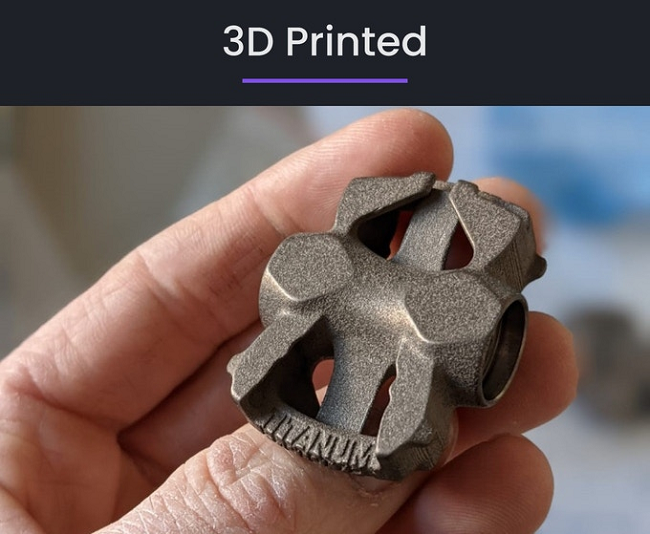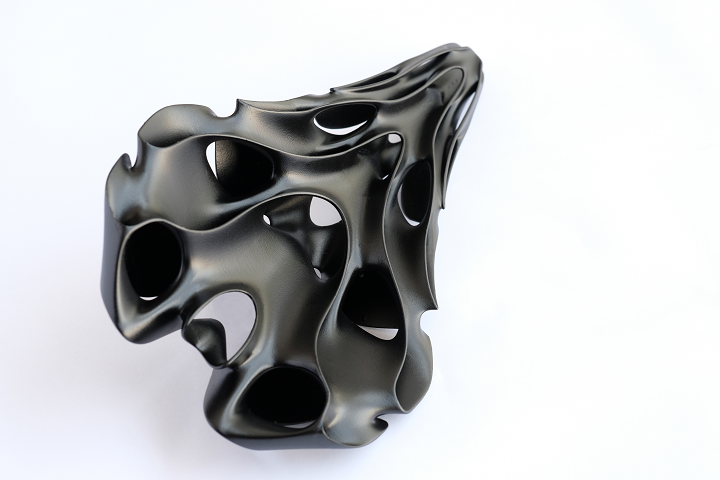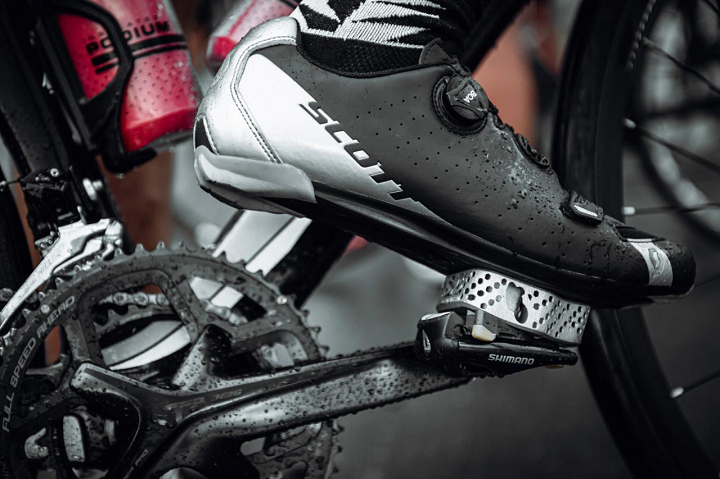In the previous articles in the Pedalution series, we looked at the prevalence of 3D printing in cycling and bike components. We’ve also explored what companies are doing with 3D printing and the value chain disruption that is likely with the use of the technology. We additionally laid out “the five forties” and other factors that accelerate 3D printing adoption in the industry and the most likely segments that will adopt 3D printing. Now, we’ll look more broadly at a number of other market segment scenarios that could lead to the adoption of 3D printing in bicycle manufacturing and how likely it is that each will bring about that end result.

Nyxo Bike Saddle Rendering
As mentioned before, the below scenarios are likely to bring about more widespread 3D printing in this industry, broadly speaking:
- Existing small players can continue to be innovative, using bicycle components that differentiate themselves.
- Other companies, such as Cinelli, are much smaller but could use technology’s cutting edge to remain competitive in Europe-based production through 3D printing. Since they already make components and bikes it would let them in an integrated way develop new bicycles using 3D printing.
- Fizik and other components manufacturers could easily implement mass customized premium offerings.
- Canyon and Rose, as well as other web-only or direct-to-consumer brands, could integrate 3D printing in manufacturing to produce bikes more quickly and to make parts in-house.
- New players can use 3D printing to disrupt the existing market.
- Chinese suppliers could rely on China-made 3D printers to differentiate their offering and move up the value chain. Perhaps in some cases, they could build their own brands off the back of 3D printing.
- Specialized components suppliers, including Miche, can branch out into new products using small production runs and 3D printing.
- Companies could grow by 3D printing previously out-of-production parts.
- Multi-brand companies like Accell and Pon Holdings could differentiate across brands by implementing 3D printing.
- On the whole, some companies such as Giant would be large enough to implement 3D printing across many quality fields, materials, and processes. Indeed, Giant is the largest manufacturer of bicycles, making all types at all price points with different technologies in Taiwan. They also produce components, a lot of frames, and entire bikes for many other players. They could adopt 3D printing wholesale to gain an advantage over upcoming Chinese suppliers.
- Companies including Campagnolo or SRAM could use 3D printing to make outperforming, high-end components with 3D printing.
- 3D printing could become a buzzword for the entire industry and many players can take to it simultaneously, as happened with carbon fiber frames.
- A company could 3D print all of the components that make up a bike and completely disrupt the market.

1. So far, small players have been the largest adopters of 3D printing. As mentioned in our previous article in this series, these firms can quickly innovate and create profitable products in this way. The fervor with which mainly small, niche, brands have made innovative 3D printed parts seems in no danger of abating. We would expect more of these companies to manufacture components with 3D printing, given the success of other players.
2. Italian and other heritage parts manufacturers have been under threat since the 1960s. Indeed, in countries such as Italy and the U.K., much of the cycling supply chain has been annihilated over the past several decades. In many other industries, we can see firms turn to 3D printing to reduce stock and offer locally-made products faster to market. Italian pride and branding are strong and one could imagine people paying more for parts “made in Switzerland” and other national monikers, as well.
With COVID-19, supply chain disruptions, which were especially heavy in cycling, these firms will have hopefully looked at 3D printing as an alternative to globe-trotting supply chains by now. Given their scale and brands, many of these businesses would not find it difficult to produce a line of 3D printed products together with partners. Long-term investment and expertise in CNC and other technologies has deterred these players from examining new technologies thus far. Based upon our previous 3D printing experience, we would consider it especially fruitful for these companies to consider the technology.
3. For component manufacturers, the technological cutting edge and the marketing of this edge can help them shift a lot of very ordinary parts. Much smaller firms have made 3D printed products competing directly with these businesses, but so far only bicycle seats have been tempting for these players. Reliance on current business models and ways of operating seems to be bringing about inertia in this segment. Either Mario has been making this with a lathe for decades or they’ve been performing the design and outsourcing since recently. In both cases, we can see firms here, who have a ton to gain from 3D printing, not really turn to the technology with as much aplomb and enthusiasm as other, smaller peers.

4. As stated before, we believe 3D printing to be eminently suited to the direct-to-consumer companies, such as Canyon. These businesses are more likely than others to take 3D printing in-house and be able to implement the technology well in their organizations. Uptake has been slow here so far, but in between these companies and against newer direct-to-consumer outfits, 3D printing could make all the difference.
5. We are seeing new players use 3D printing as a marketing and development tool to bring new products to market in e-bikes, parts, road bicycles and much more. We would expect this trend to grow.
6. We have seen a growth in Chinese direct-to-consumer firms exploiting Kickstarter, Instagram or other direct-to-consumer platforms to build large profitable global businesses. Many Chinese businesses are currently selling direct-to-consumer components and accessories and we would expect some of these enterprises to build much wider bike brands with more products.
7. Companies with little in the way of branding could very well build a brand and expand their offerings through 3D printing. Differentiating boring components could be marketed more widely. A company such as Miche could manufacturing an ultra-lightweight gear component. Crankbrothers could produce ultralight, 3D printed pedals and use this to move beyond the crankshaft. SRAM started with shifters and, slowly but surely, started making the rest of the bike, as well. This would require a lot of imagination by these players, but the payoff would be huge. And a lightweight titanium component like this would not be hard to do as a one-off.
8. It is mystifying to me that no one single person has so far established a startup to make “out-of-production” bike components. The market would be large. It would be comparatively easy to do. And it would be very profitable. Especially when relying stereolithography/vat polymerization in combination with casting, you’d be able to make a lot of these parts rather inexpensively. Someone, please do this!
9. Large, complex companies are often too busy holding meetings about innovation to actually innovate. The multi-brand firms have the wherewithal to implement 3D printing, but, usually, a lack of incentives and coherent vision across brands stops companies like these from implementing new technologies well. Some of these firms see themselves more like Nike, focusing on design and marketing, while others have extensive production, so your success may vary here. By making redesigned and different-looking components through the same techniques, these companies can have a lot to gain from 3D printing.

Additively manufactured cleat positioned between shoe and pedal on Stevin Creegan’s race bike.
10. What does Giant want? If it wants things to stay the same, it will not look at newfangled technologies. It has experienced major disruptions due to COVID itself. Its success is also due to a large shift from tubular steel toward carbon fiber frames that it is good at making. Sharp increases in labor rates and a reliance on highly polluting inputs and parts must have Giant on the lookout for new technologies.
I would expect Giant and other similarly sized firms to be on the lookout for any automation for Carbon Fiber frame manufacturing. But, teeny, tiny BMC is the one with a breakthrough in carbon fiber production. It has demonstrated how companies can compete even though they are in high-labor countries, such as Switzerland however. So, in this case, we don’t know if Giant’s heft will have it outmaneuver everyone else in a dainty manner or if it will continue lumbering ahead.
11. It would be difficult and expensive to make 3D printed groupsets. Performance optimization would be difficult to achieve, as would the tight tolerances needed for gears and other components. Through lightweighting or new types of components, some people may be able to make headway in this market.
12. This is as of now not likely. 3D printing is very niche for cycling. But, if a Tour De France winner had a 3D printed, mass-customized bike that was seen to bring advantages to cycling, this may rapidly change.
13. It would be very difficult to manufacture a completely 3D-printed bike. You’d have to master directed energy deposition or carbon fiber 3D printing for the frame, powder bed fusion for the high-quality components, and binder jet for lower quality components. The payoff would be significant, as you could make the entire thing almost completely to order in-house. Just like the Italian artisans of old, you could create a unique form for one rider.
The above scenarios are the most likely, but what technologies would make what impacts?
Subscribe to Our Email Newsletter
Stay up-to-date on all the latest news from the 3D printing industry and receive information and offers from third party vendors.
Print Services
Upload your 3D Models and get them printed quickly and efficiently.
You May Also Like
Reinventing Reindustrialization: Why NAVWAR Project Manager Spencer Koroly Invented a Made-in-America 3D Printer
It has become virtually impossible to regularly follow additive manufacturing (AM) industry news and not stumble across the term “defense industrial base” (DIB), a concept encompassing all the many diverse...
Inside The Barnes Global Advisors’ Vision for a Stronger AM Ecosystem
As additive manufacturing (AM) continues to revolutionize the industrial landscape, Pittsburgh-based consultancy The Barnes Global Advisors (TBGA) is helping shape what that future looks like. As the largest independent AM...
Ruggedized: How USMC Innovation Officer Matt Pine Navigates 3D Printing in the Military
Disclaimer: Matt Pine’s views are not the views of the Department of Defense nor the U.S. Marine Corps Throughout this decade thus far, the military’s adoption of additive manufacturing (AM)...
U.S. Congress Calls Out 3D Printing in Proposal for Commercial Reserve Manufacturing Network
Last week, the U.S. House of Representatives’ Appropriations Committee moved the FY 2026 defense bill forward to the House floor. Included in the legislation is a $131 million proposal for...

































